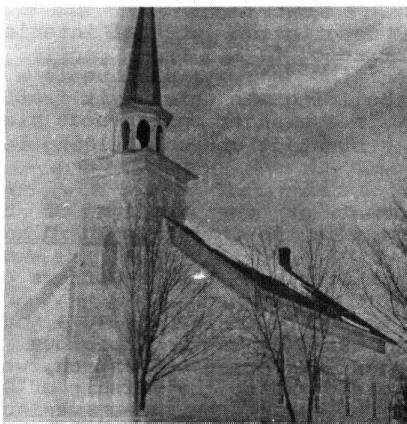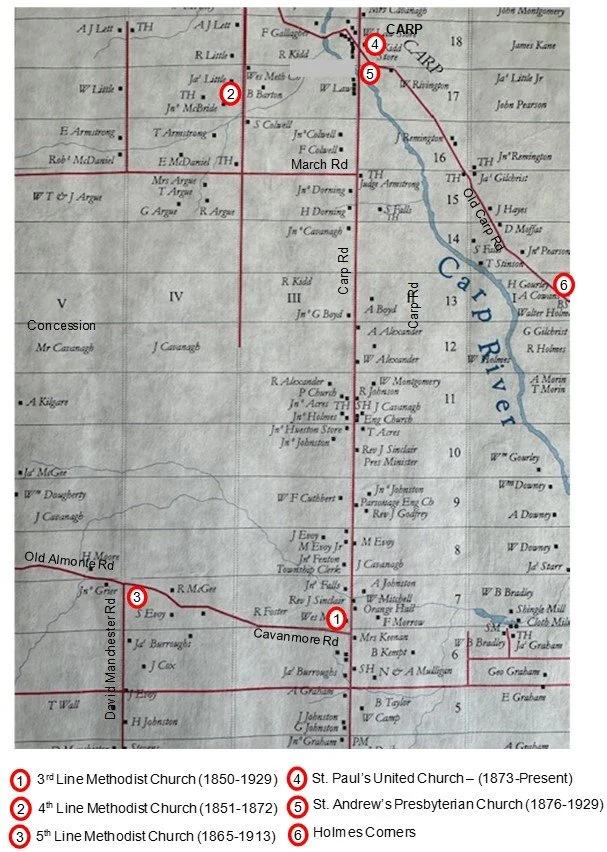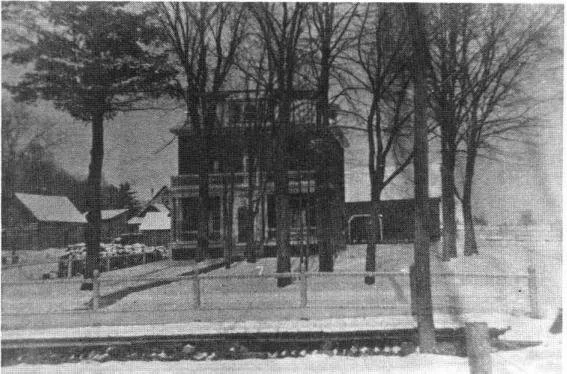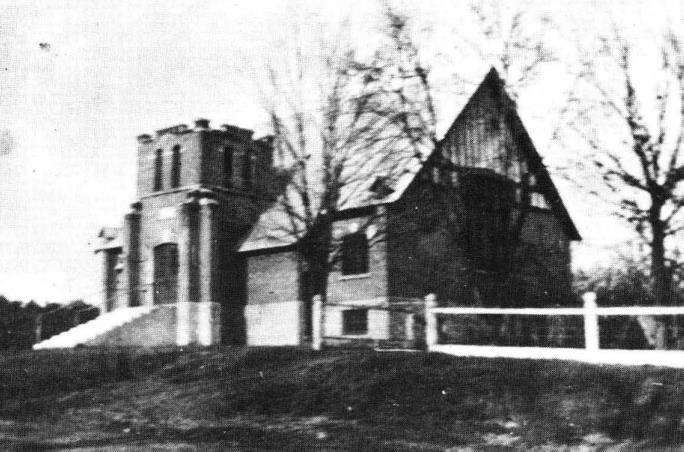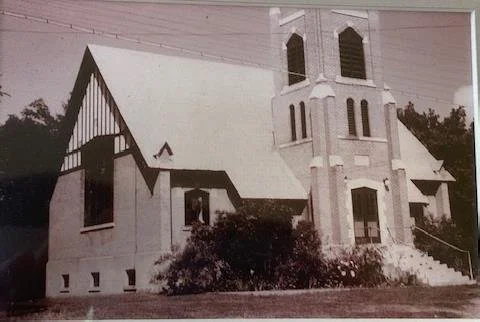
History of St. Paul’s United Church
The Methodist Episcopal Church of the United States had established several strong circuits in these older military settlements, and from 1820 onward, American Methodist preachers from the Rideau circuit and the Ottawa River Circuit found their way into the Goulbourn-Huntley settlement. The Irish Methodists did not care for the American preachers because of their political opinions, which were sometimes tainted with anti-British attitudes, and they were unwilling to be formed into Class Meetings by them. On May 8, 1822 a "Petition of the Stewards and Trustees of the Wesleyan Methodist society in the Military settlements in the county of Carleton" was forwarded to the Wesleyan Methodist Missionary society office in London, England requesting a British Methodist minister, and stating that they did not wish to be under the jurisdiction of the Methodist Episcopal Church of the United States.
In 1820, the British Wesleyan conference and the Methodist Episcopal Church of the United States agreed to avoid competition in their work in British North America. The Americans were to work in the United States and Upper Canada, except for the city of Kingston. The British conference was to look after all other sections of British North America, including the British West Indies and Bermuda. The petition of the Methodists of Carleton County was not accepted by the British Wesleyan Missionary Society, and, in 1822, the Rev. Ezra Healey was appointed by the Genesee conference of the Methodist Episcopal Church of the United States to the Rideau Circuit. The following year, having abandoned all hope of securing a British minister, the Methodists of Carleton County accepted organization under the American Methodist Episcopal Church.
In the years prior to 1824 in Huntley Township, there were primarily three religious groups – Anglican, Presbyterian and Methodists. Amongst these early Irish settlers were several Methodist families, including three local preachers and class leaders, Thomas Shillington, George Argue and Hugh Ronan. Methodist services were held periodically at different private residences.
Mr Andrew Glen, Presbyterian minister (1824-1826) in Richmond, called at these private residences, He was the first resident clergyman of any denomination to conduct public religious services in Huntley and Mr. Henry McBride's house was the first place in which these services were held. The first Methodist minister to preach in Huntley Township was the Reverend George Farr in 1826. The Methodist families at that time were Argue, Caldwell, Hayes, McCord, Lucas, McBride, McDaniel and Kemp
From 1827 to 1858, the Methodists of Huntley were served by the ministers of the Richmond circuit. The Richmond circuit was a two week circuit with fourteen preaching points and embraced or extended to the following townships: Goulbourn, North Gower, Marlborough, Beckwith, Montague and Huntley.. However, most of the services were conducted by local preachers such as Thomas Shillington, George Argue and Hugh Ronan.
In May of 1828, the General conference of the Methodist Episcopal Church of the United States granted autonomy to the Canada conference. The latter body became known as the Methodist Episcopal Church in Canada
In 1833, a union of the Methodist Episcopal Church in Canada and the British Wesleyan Conference took place. The church was renamed The Wesleyan Methodist Church of Canada.
The 1841 list of subscribers to the Wesleyan Missionary Society from Huntley Township included: Hugh Ronan, Henry McBride, Forrest Caldwell, Kenneth McCaskell, Robert Argue, John Crosier, Mary Lowry, Ann Stitt, Mrs. Rose, Wm. McCord and William Peever.
Services of worship continued to be held in the homes of the congregation.
During the pastorate of Rev. William Andrews (1848-1850), a native of Yorkshire, England, the third line chapel (1850) and the fourth line chapel (1851), were erected. A Conference Chapel Grant of L 6.7.6 was given toward the third line chapel and another L 5 to the fourth line building.
There were three Methodist churches built in lower Huntley Township between 1850 and 1865:
1. Third Line Church – 1850–1929 - In 1850, the first Methodist church built in the Township was the Third Line Church. It was a small white frame building 24 x 36 feet on the site of the present Huntley United Cemetery vault (2605 Carp Rd. – Carp Road and Cavanmore Rd.). At that time, some of the families were Manchester, Clark, McGee, Taylor, Dougherty, Didsberry, Evoy, Swallwill, Pettipiece, McAllum, Bayliss, Edey and Howey. The property (1 acre) was purchased by the Wesleyan Methodist Church from William Booth in 1850.
2. Fourth Line Church – 1851–1872 - The Fourth Line Church, built in 1851, was a larger and a better finished building located on the north-east corner of the south half of Lot 17, Concession 4, Huntley (now 1735 Thomas Argue Road). This property was donated by Henry McBride Sr. The log constructed chapel was often referred to as “the meeting house” rather than the chapel or church.
3. Fifth Line Church – 1865–1913 - By 1866 the Huntley congregation had become sufficiently strong to undertake erecting another church. A 1/4 acre lot (Lot 7, Conc. 4) was purchased from Robert McGee and the land was registered on April 1, 1865 to the Methodist Church trustees. The Fifth Line church (later known as Bethel) was built on this lot on the southeast corner of the 5th Line (now David Manchester Rd.) and Old Almonte Road for $800 exclusive of voluntary labour. A parsonage was built across Old Almonte road from the church (north east corner). The church was demolished in 1913 and the property sold to Roland McGee, registered on March 17, 1914.
In 1860, Rev. Levi Vanderburg was appointed superintendent of the Bell's corners Mission and also a new Mission called "Carp". Forty members were separated from Bell's corners to form the Carp Mission but these were reunited with the parent group the following year. The Fourth Line congregation was not part of this mission.
In May of 1863, the membership at the Fourth Line of Huntley was ninety-three. There were fifty members at the Third Line and the new Fifth Line class had forty-eight members, some were formerly members of the Fourth Line chapel. By 1869, the old Fourth Line Church was reduced to forty-nine members and the two Holmes’ Corners (Old Carp Rd. and Huntmar Rd.) classes had a total of forty-five members.
The Methodist Episcopals had now firmly established themselves in Huntley township, having a resident minister living beside their church on the Fifth Line of Huntley at the corner of "the main road leading to Almonte" (now Old Almonte Rd. and David Manchester Rd.). Their minister, Rev. David Brill, was holding regular services at Carp, (the first clergyman of any denomination to do this). Also, he was preaching at two points in March township, at the Sixth Line of Huntley, at Almonte and in Fitzroy township..
On August 17, 1870, a bush fire started near Almonte and fanned by near hurricane winds, burned across part of Huntley, March, Goulbourn and Nepean Townships destroying everything in its path. The Third Line Wesleyan (Methodist) Church was burned but not the Fourth Line or Fifth Line chapel. The disastrous fire of 1870 put an end to Rev. David Brill’s expansive activities of the Methodist Episcopals in Huntley. A new church was built on the Third Line site in 1872.
Huntley Methodist Church
Built 1872, Demolished 1929
A relief fund was organized across the province to aid the victims of the fire, and with help from this fund the district soon recovered. In many ways the blaze proved fortunate, since it cleared away old stumps, remaining patches of bush and beaver dams, as well as many of the old log houses and shanties dating from pioneer days. In their place, substantial new brick houses were built and roads were opened through what had once been swamps and morasses formed by beaver dams and fallen trees along the Carp River.
During the fall and winter of 1872 plans were formulated for the erection of a church in Carp which would include in its congregation the Fourth Line of Huntley and Holmes’ Corners (Old Carp Road and Huntmar Rd) class meetings. Construction of a substantial wooden structure, at a cost of $2,800, capable of seating three hundred people started.
The building was thirty-six feet wide, sixty feet long and had a tower with a slender spire about sixty feet high. It was the largest rural Protestant church building in Carleton County at the time.
Wesleyan Methodist Church, Carp - 1873
In September of 1874, the Wesleyan Methodist Church in Canada, the Wesleyan Methodist church of Eastern British America (the Maritimes, Newfoundland and Bermuda) and the Methodist New Connexion Church in Canada united to form Canada's first nation-wide religious organization, the Methodist Church of Canada. The union did not affect the Carp Circuit, as New Connexion Methodism had disappeared from the community twenty years prior.
In 1879, the Bell’s Corner’s circuit was changed to "Carp" and the minister's residence was transferred from Bell's Corners to Carp. A frame parsonage was erected on the site of Mrs. John Wall's house and this served as the minister's residence.
In July of 1884, the "Methodist Church" which entered the United Church of Canada came into existence. This body was a union of the Methodist Church of Canada, the Methodist Episcopal Church in Canada, the Primitive Methodist Church in Canada and the Bible Christian Church in Canada. The Methodists were now the largest Christian body in Ontario, and the largest Protestant denomination in Canada.
Following the Methodist union of 1884, the various circuits in Ontario were consolidated. In 1885, the former Huntley Methodist Episcopal Church was added to the former Carp Wesleyan Circuit and became known as the 5th Line Church. In 1895, it was renamed Bethel Church, and continued as such until it was finally merged with the 3rd Line Church to form the Huntley Centre congregation in 1902.
Below is a map of the Methodist Churches and St. Andrew’s Presbyterian Church in Huntley Township.
The Rev. William Williamson was appointed minister in 1898. His father was a lumberman of substantial means, and this gentleman built an elegant parsonage for the circuit, complete with gas lighting and indoor plumbing, for $4,300. This eleven room house was the United Church manse (now 382 Donald B. Munro Dr., Carp).
Methodist Parsonage, Carp – Built in 1898
The contractor for the Carp church had not built a proper foundation under the building, and by 1900, it was in bad condition. The sills had rotted under one wall, water also seeped into the attic from the steeple.
In 1905, the condition of the church was discussed at a trustee meeting. Shortly after this meeting, part of the ceiling fell and the building could not be used for public worship. The congregation worshipped in the Presbyterian Church and the Orange Hall until the ceiling was replaced. At a meeting of the Trustee Board in June of 1906, the minister, Rev. W. H. Raney "put it squarely before the members" that it was time to build a new church. A contractor was engaged to examine the building, and he recommended that a new church be built, since it would cost little more than rebuilding the old one. No further action was taken until 1908, when an architect (Mr. McLaren of Ottawa) produced plans for a new church, with the same seating capacity as the old one and also plans for renovating the existing building. He recommended a new building. Again no action was taken.
At the Trustee Board meeting of September 19, 1908, it was reported that a "great change had come in the feelings of the people with regard to the renovating of the church". The members now realized that the old building was so deteriorated that it was almost worthless. It was moved by William Argue and seconded by Dr. Groves, that a new church be built “when the time comes". It was decided to do nothing for a year.
The Rev. George Macintosh was the minister in 1911. Within four months of his arrival, building plans were underway. A new architect (Taylor and Horwood of Ottawa) was engaged to draw plans for a church of solid brick construction," with a tower and a basement with a nine foot ceiling". A building committee, consisting of Dr. George Groves, Dr. A.E. Hunt, S.L. Gilchrist, T.E. Argue and R. Elliott, was appointed and the work started.
The church was of solid brick construction, with acetylene gas lighting, cathedral glass windows and attractive oak and ash furnishings. The basement area was nicely finished for Sunday school and mid-week activities. At the time, it was the finest rural church building of any denomination in Carleton County.
The dedication service was held the third Sunday of December, 1912, with the Chairman of the Ottawa District Meeting of the Methodist Church, the Rev. Charles Deeprose, officiating. A second service was held in the evening, and the Monday following, a dinner was served in the basement, followed by an address. The choir of the Dominion Methodist Church, Ottawa provided special music. There was a large assembly of people from all the churches in the township present for the dedication ceremonies.
Methodist Church, Carp - 1912
In 1925, the Carp and Huntley congregations passed into the United Church of Canada, along with all other Methodist congregations in this country. Since there were to be two United church congregations at Carp for a time, the patronal name "St. Paul" was adopted. In June of that year, the Dunrobin congregation, previously part of the Fitzroy Methodist circuit became the third appointment.
The first vote on church union of St. Andrew’s Presbyterian and Carp Methodist congregations was taken in 1915. The congregation’s background with the Church of Scotland made a positive vote for union unlikely.
The decision of the Presbyterian General Assembly of 1921 to proceed with entry into the proposed United Church of Canada forced the issue upon congregations. An anti-union organization, ‘The Presbyterian Church Association’ had been in existence since 1912, with the avowed purpose of trying to prevent congregations from entering the new church. A representative of this body visited Carp in March of 1924, but did not create a very favourable impression. The minister, Rev. Gladstone Wood, was a strong supporter of the union, as were almost all of the ministers of the Ottawa Presbytery.
In April 1927, the way seemed clear to effect an amalgamation of St. Andrew's Presbyterian and St. Paul's United congregations, An ineffective committee was appointed by the Ottawa Presbytery, which produced a foolish plan for the amalgamation of the two pastoral charges. The proposal received the treatment it deserved, and Carp, St. Andrew's took steps to call another minister.
In 1929, a new committee was appointed by the Ottawa Presbytery to affect a union between the two congregations at Carp. This time a realistic basis was proposed. Both the Huntley and Diamond churches were to be closed and the Kinburn congregation became part of the Fitzroy Harbour Pastoral Charge. Both St. Paul's church and parsonage were to be retained; the settlement committee of the Montreal-Ottawa Conference was to appoint the first minister, who was to be a former Presbyterian; St. Andrew's manse and church were to be sold, with the proviso that the church was to be sold only for a purpose that would be in keeping with a building dedicated to the Glory of God.
Since the St. Andrew's congregation were giving up both their church and manse, it was agreed that the first minister should be a former Presbyterian (Rev. Robert C. Eakin). In case there might be any division of opinion over the choice of the minister, the Settlement committee of the Conference was asked to make the appointment. The Presbyterian order for the celebration of the Lord's Supper was adopted, and the Methodist practice of kneeling at the Communion Rail discontinued. Both the Hymn Book and the Book of Praise were to be used until the new United Church Hymnary was issued. The choir gowns and caps from St. Andrew's were to be worn, an innovation for the former Methodists since their choir had not worn gowns; but, as a concession to any Methodists with deep-rooted evangelical sentiments, at first the minister did not wear a Geneva gown, as had been the practice at St. Andrew's. It was decided to engage the services of a professional organist, in the person of Mr. J.W.G. Roberts, the music supervisor for the schools of the area.
The new United Church congregation at Carp was to cover the geographic area of Huntley Township. Families who formally attended Lowry Church and lived in Huntley were to come to Carp.
The final service was held in St. Andrew's Presbyterian Church on the morning of June 30, 1929 and that afternoon the members went to the former Methodist church for the official Presbytery service constituting the new congregation of Carp St. Paul's.
At first the church was called Carp United Church, but it was soon agreed that "St. Paul's" should be retained as the patronal name of the congregation. The former Presbyterians were strongly represented on the new committee of stewards while three were elected elders for life from each of the two pastoral charges. Elisha Graham and F.S. Caldwell represented St. Paul’s, E.P. Pearson, G.H. Richardson and Lowry Gourlay St. Andrew's, and G.H. Acres Huntley Centre Church. There was no elder from the former Lowry Church, although it was represented on the committee of Stewards and Trustees.
The new elders were inducted into office at the amalgamation service held on the afternoon of the last Sunday of June, 1929. This Service was conducted by the Chairman of the Ottawa Presbytery, Rev. Dr. L.S. Hughson, assisted by Rev. J.I. Horsey, Rev. F.S. Millikem and Rev. Arthur Shorten. Rev. Dr. John W. Woodside, long minister of Chalmers Church in Ottawa was the preacher. The church was filled beyond capacity and all the members went away convinced that great things indeed would now be possible.
Rev. Robert C. Eakin was appointed by the Settlement committee as minister of the amalgamated congregation and he was inducted into the Pastoral Charge by the Presbytery of Ottawa on Thursday, July 17th, 1929 at a well-attended service,
By 1929, St. Paul's Church building needed some major repairs. Little had been spent on maintenance since its erection in 1912. During Rev. Eakin's pastorate (1929-38) the tower was rebuilt, the churchyard attractively landscaped and both the inside and the outside of the building repaired and repainted.
St. Paul’s United Church – Tower Completed
After a pastorate of a little over nine years, the Eakins left the charge in October of 1938. The two years 1937 and 1938 were difficult ones for the congregation. The prolonged financial depression was having its effect. Death carried off several members. In 1938 alone there were eighteen funerals in the congregation, including many of the leading officials, amongst them Forrest S. Caldwell, long time Sunday School Superintendent. Others moved away. People with a deep insight into the affairs of the congregation at the time knew that during these years, had it not been for the efforts made by the minister and his wife, the charge would have been in difficulties.
Rev. C.K. Mathewson came to the charge in the winter of 1939. He had an unhappy pastorate at Carp. The congregation had agreed to the old Scottish custom of having a long series of ministers preach for a call. After many ballots, a minister was chosen, but it was not an unanimous call. The congregation became hopelessly divided. Death continued to carry off leading members. Young people and others removed from the community because of the war. Early in 1940, Dr. A.B. Hyndman, long time leading member of St. Andrew's and St. Paul's passed away. There were less than ninety families. Gloom seemed to penetrate every aspect of the life of the congregation.
The return of peace in 1945, together with the dedication of Rev. W. R. and Mrs. Johnston (1941-46) started to revive interest in the church. Rev. Johnston was succeeded by Rev. F.W. Taylor in February of 1946.
In the early 1950's new families started to move into the district. Pews that had been vacant for several years again started to be occupied. The effect of this new blood was seen on some of the old members who started once again to attend service with some degree of regularity, and interest revived. In 1953, Mrs. T.E. Argue, long a devoted member placed an oak communion Table in the church in memory of her husband and his father, Wm. Argue.
Rev. S. W. Atchison was inducted into the charge in the fall of 1955 and remained until June of 1962. During Mr. Atchison's pastorate the number of families continued to grow and once again the Church was completely filled on Sunday mornings. The new United Church Women's organization came into existence in 1961 with a membership of fifty-eight, divided into five units. The orders of worship, as contained in the Book of Common Order, were introduced and a new organ was presented to the congregation by Mr. and Mrs. G.P. Gamble.
Rev. Stanley A. Smith was inducted as minister in July of 1962. During his pastorate the congregation continued to grow. One of the outstanding features of life in the congregation during these years was the high level of music at the services of worship. The choir had thirty-five to forty members, most of whom were young people. They were often called upon to participate in special services in neighbouring congregations. There was an active youth group in the congregation and strong Boy Scout and Cub groups.
St. Paul’s church, built in 1912, had become too small for the growing congregation. At congregational meetings held during 1964 a building committee. with Mr. Graham Lucas as chairman, Rev. S.A. Smith as Secretary, Dr. M.B. Davis, Garfield Boyd, Barry Hanson, Theodore Carruthers as stewards, Dr. E.F. Johnston as Trustee, Wm. A. McCallum as C.E., W. P. Kennedy as session, Mrs. H.J. Montgomery and Mrs. Ira Boucher as U.C.W. was appointed, and the architectural firm of Ingram and Pye of Ottawa were engaged to draw plans for a rebuilt church. At a largely attended congregational meeting in December of 1964, a plan was unanimously approved which provided for a building with ten thousand square feet of floor space. The walls of the old building were incorporated (to be re-bricked on the outside) but apart from four stained glass windows and various memorial plaques, little else of this building remains. The new building, dedicated December 3, 1965, is one of the finest churches to be found in any village in Canada.
St. Paul’s United Church - 1965
Rev. Stanley Smith resigned in June of 1967 and he was succeeded by the Rev. Donald G. Boyd. Immediately prior to Mr. Boyd's arrival a major renovation of the Manse (382 Donald B. Munro Dr.) was undertaken, again under the direction of Mr. Graham Lucas. This stately old house, erected in 1898, had begun to show the ravages of time. New plumbing, wiring, bathroom, kitchen and hot water heating were installed and the house was re-plastered and redecorated.
As had happened many times before, when things started to look bright, misfortune struck the congregation. The economic base for the village carp had always been the surrounding farm area. During the 1960’s, the number of farm families fell to a fraction of what it had been. Once prosperous businesses in the village ceased to exist for lack of a clientele and most of those persons who operated them either removed from the community or died and were not replaced. Within a short time the congregation had lost over eighty of· its most faithful supporter, coupled with this was the scepticism, the permissiveness and the anti-religious attitudes of the sixties, which made it unfashionable to support the faith which has been the foundation of our western way of life. A much smaller congregation was faced with a debt of almost ninety thousand dollars.
In July of 1970, the Rev. Frank B. Stiles was inducted as minister. Recent housing developments in the area contributed new families and through the hard work of Rev. Stiles the congregation was once again recovering strength.
Below is a list of the Methodist/United ministers in Huntley Township from 1824 to 2024:
NOTE: Mr. Andrew Glen, Presbyterian minister (1824-1826) in Richmond was first resident clergyman of any denomination to conduct public religious services at Henry McBride’s house (Methodist) in Huntley.
1825 David Wright, George Farr
1826 Jacob Poole
1827 George Poole
1828 Richard Jones
1829-1830 John H. Huston
1831 Charles Wood
1832-1833 William H. Williams
1834-1835 James Currie
1836-1837 Daniel Berney
1838 George Goodson
1839 Asahel Hurlburt, Geo. F. Playter
1840 Asahel Hurlburt, Lachlan Taylor
1841 Henry Shaler
1842 Henry Shaler, James Elliott
1843 John Armstrong, Charles Taggart
1844 John Armstrong, John Howes
1845 Benjamin Nankeville, Thomas Hanna
1846 Benjamin Nankeville, David C. McDowell
1847 Benjamin Nankeville, William Chapman
1848 William Andrews, Noble Armstrong
1849 William Andrews, William A. Pattyson
1850 William Andrews, William McGill
1851 James Greener, Silas Huntingdon
1852 James Greener, Robert Hobbs
1853 James Greener, Richard Hammond
1854-56 Thomas McMullen
1857 Wil1iam Scales
1858-60 Robert Robinson
1861-63 Levi Vanderburg
1864 Edmund E. Sweet
1865-66 Richard Wilson
1867 John A. Dowler
1868-70 David C. Chalmer
1871 Webster W. Leech, Thomas Hadden
1872 Webster W. Leech, Arthur Whitesides
1873 Jabez Keough
1874 Jabez Keough, Benjamin Franklin
1875 Jabez Keough, Nassau B. Topping
1876 Richard N. Adams, Wm. S. Jamieson
1877 R.N. Adams
1878 Richard N. Adams, Joseph Earl
1879-81 John J. Leach
1881-84 William Pearson
1884-88 J.V. McDowell
1888-89 James E. Richardson
1889-93 John Ferguson
1894 Carl Allum
1895-96 J.M Tredrea
1897-1900 William Williamson
1900-03 Geroge I. Campbell
1903-06 Wesley H. Raney
1907-10 James W. Humphrey
1910-11 Frederick G. Robinson
1912 George McIntosh
1913-16 E. Richardson Kelly
1916-18 Lawrence H. Fisher
1918-21 J. Ernest Brownlee
1921-26 Ernest Codling (St. Paul’s)
1927-29 Arthur F. Shorten
1929-38 R.C. Eakin
1939-41 C. K. Mathewson
1941-46 W.R. Johnston
1946-55 F.W. Taylor
1955-62 S.W. Atchison
1962-67 Stanley A. Smith
1967-1970 Donald G. Boyd
1970-87 Frank B. Stiles
1988-96 Camille Lipsett
1996-97 David Estey
1997-2005 Heather Moore
2006-09 Mead Baldwin
2009-10 Suzanne Sykes
2010-14 Karen Boivin
2014-16 **
2016-24 Debbie Roi
** With the capable assistance of Eileen Hepplewhite and Neil Wallace, voluntary associate Ministers
The above Ministers were part of the following Circuits:
1825-26 - Rideau Circuit
1827-1853 - Richmond Circuit
1854-57 - Huntley Mission
1858-78 - Bell’s Corner’s Circuit
1879-1925 - Carp
1925-2024 - St. Paul’s, Carp
Note: The above history of St. Paul’s United Church was primarily obtained from Glenn Lucas’s book ‘“St. Paul’s Church, Carp, Ontario, 1824-1974”


